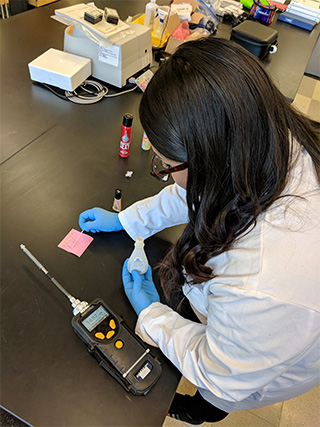Partnerships for Environmental Public Health (PEPH)
Study Location: Tucson, Arizona
Academic Partners:
University of Arizona
Paloma Beamer, Ph.D.
Sonora Environmental Research Institute, Inc.
Ann Marie Wolf

An undergraduate student tests the emission rates of different beauty products in the laboratory.
(Photo courtesy of Paloma Beamer, Ph.D.)
Community Partners:
El Rio Community Health Center
Nancy Johnson, Ph.D.
Project Description
The goal of this project is to reduce hazardous occupational exposures and associated health outcomes amongst small businesses that employ Latino workers. Small businesses are more likely to employ low-wage Latino workers, who often use hazardous chemical agents that pose risks for several respiratory, cardiovascular, neurological, and cancer outcomes. Latino workers face a disproportionate burden of occupational disease and injuries, and often lack access to culturally appropriate occupational health education and prevention information due to economic, physical, and social barriers.
Community health workers (CHWs) have proven to be effective in outreach and environmental health education to Latino communities, specifically those who are employed as farmworkers. According to the American Public Health Association, a CHW is a frontline public health worker who is a trusted member of a specific community, and usually has a close understanding of the community’s needs.

Study participant wearing a monitor.
(Photo courtesy of Paloma Beamer, Ph.D.)
The El Trabajo no te Debe Dañar project will utilize a CHW-led intervention and community-engaged research framework to reduce occupational health disparities in the Latino community. Investigators will work closely with small business owners and employees to select and implement exposure-reduction strategies that are appropriate for their worksite to prevent occupational disease and injuries.
Specific project aims are to:
- Quantify workplace exposures to volatile organic chemicals (VOCs) in a cross-section of small businesses that represent two commonplace, high-risk industries: auto repair shops and beauty salons.
- Design a CHW intervention to reduce workplace exposures to VOCs based on identified exposure priorities.
- Conduct a study to evaluate the efficacy of a CHW intervention at reducing workplace exposures to VOCs.
- Assess overall health outcomes, as well as physical, social, and economic factors of the CHW intervention that contribute towards successful use of exposure control strategies.


